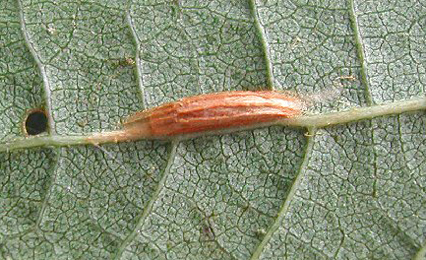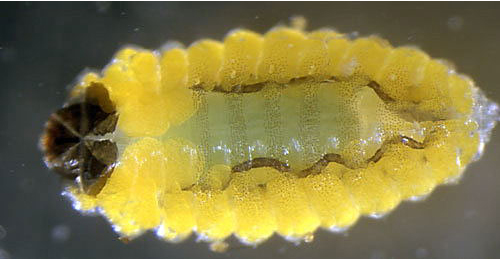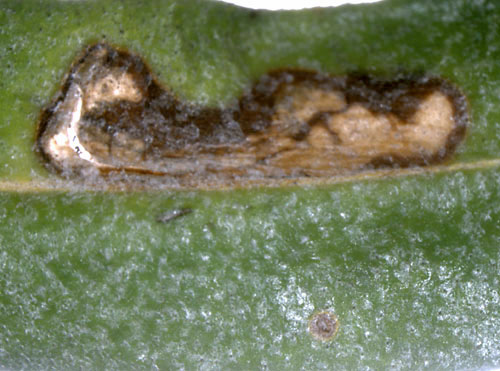|
||||||
|
MYRICA. Bog-myrtle. [Myricaceae] |
|
Two species of Myrica are recorded in Britain, Bog-myrtle (M. gale) and Bayberry (M. pensylvanica). Ten British miners are recorded on Myrica. A key to the European miners recorded on Myrica is provided in Bladmineerders van Europa. |
|
Key for the identification of the known mines of British |
1a > Leaf-miner and case-bearer: The larva lives outside the mine, protected by a case, and feeds on the underlying plant tissues via a hole cut in the epidermis. From that point it eats away as much leaf tissue as it can reach without fully entering the mine. Mine does not contain frass (Coleophora species) |
1b > Leaf-miner, but not a case-bearer: The larva lives mainly inside the mine. Mine usually contains frass. In later instars the larva may live sandwiched between two more or less circular sections cut from the leaf. |
| 3 |
2a > Leaf-miner and case-bearer: As with other Coleophorids, the larva forms a case from the leaf, in which it overwinters. The case formed by this species is long, slender and frequently woolly in appearance. Bivalved composite leaf case of 8-10 mm, rather strongly compressed and keeled, with a mouth angle of 30-45°. |
|
Coleophora lusciniaepennella (Treitschke, 1833) [Lepidoptera: Coleophoridae]. |
|
|
Coleophora milvipennis Zeller, 1839 [Lepidoptera: Coleophoridae]. |
2c > Leaf-miner and case-bearer: The larva feeds by inserting its head into small mines it creates on the leaves of birch, elm, alder, or hazel. Occasionally it is found feeding on other trees, or on herbaceous plants onto which it has accidentally Fallén. It forms two cases during its larval life. The first case is initially curved, smooth, laterally compressed with a bivalved anal opening, and about 2 mm long in September. During October it feeds, and adds a few rough collars of larval material around the oral opening. After hibernation, it feeds again in April and early May, adding more protruding collars until they equal or exceed the original smooth part of the case. At the same time, it expands the case girth by the creation of a silk gusset ventrally. The second case, 6 or 7 mm long, is formed in May, leaving the vacated first case attached to its last feeding mine. The new case is tubular with a trivalved crimp at the anal opening. The dorsum is formed from the edge of the leaf from which the case was cut. This results in a more or less serrated dorsal keel, depending on the plant species and the individual piece of leaf used. Considerable variation in the degree of serration can be found, even among specimens off the same tree. The case colour varies with food plant, from yellowish brown on birch, darkening through elm and hazel to dark brown on alder. The strongly curved young case is is a composite leaf case, the adult case is a tubular leaf case. The adult case is bivalved, about 7 mm in length; the mouth angle is around 30°. The case is straw coloured and almost always has a toothed dorsal keel (remnant of the margin of the leaf from which the case was cut). Neither larvae or cases of C. coracipennella, prunifoliae, serratella and spinella can be separated; from serratella. |
|
Coleophora serratella (Linnaeus 1761) [Lepidoptera: Coleophoridae]. |
3a > Leaf-miner: The larva of this species creates a gallery mine. The mine is similar to those of the alder-feeding Nepticulidae, but is generally shorter, with the larval exit-hole on the upperside of the leaf rather than the underside. After vacating the mine, the larva grazes on the underside of the leaf in the manner of other Bucculatricidae. Short and narrow corridor, starting at an oval, iridescent egg shell that is usually placed at the leaf underside, close to a thick vein. The larval chamber is more than three times as long as wide and is vacated through an upper surface exit slit. Frass in a narrow central black line; when the mine is made in Bog-Myrtle the thick frass line almost fills the corridor. Older larvae live free and cause window-feeding. The larva pupates in a cocoon and is illustrated in British leafminers. |
 Bucculatrix cidarella cocoon Image: Rob Edmunds (British leafminers) |
|
Bucculatrix cidarella (Zeller 1839) [Lepidoptera: Bucculatricidae]. |
3b > Leaf-miner: Initially a lower epidermal gallery which leads to a blotch at the leaf-edge. Subsequently creates two or three cones by folding the edge or tip of a leaf downwards. The mine begins with an unusually long lower-surface epidermal corridor that often follows the midrib for some distance, but finally turns towards the leaf margin, where a small blotch is made of up to 1 cm in diameter. The blotch initially is fully epidermal, but later the larva starts consuming parenchyma, silk is deposited, and the blotch begins to develop into a somewhat contracted tentiform mine. In the end the mine is vacated and the larva continues living freely under a leaf fold that has been fixed with silk, or in a leaf tip that has been turned into a cone. Pupation in a shiny cocoon at the underside of the leaf. |
|
Caloptilia stigmatella (Fabricius, 1781) [Lepidoptera: Nepticulidae]. |
3c > Leaf-miner: Oviposition in the midrib. From there a corridor the larva enters the lamina which suddenly and strongly widens. The larva finally pupates in a globular cocoon inside the mine. Because the mine is formed when the leaf already is fully developed mined leaves have a normal shape. |
|
Orchestes iota Fabricius, 1787) [Coleoptera: Curculionidae]. |
3d > Leaf-miner: Generally small, upper-surface, pear-shaped mines, half of their surface stuffed with frass. In the frass-free part an oval, flattened larva. Often several mines in a leaf. Prior to oviposition the larvae eat, a large number of tiny holes in the leaves. |
 Rhamphus pulicarius larva, dorsal Image: © Willem Ellis (Bladmineerders van Europa) |
|
Rhamphus pulicarius (Herbst, 1795) [Coleoptera: Curculionidae]. |
3e > Leaf-miner: A contorted gallery leading to small blotch. Egg at the underside of the leaf, mostly close to a vein or the leaf margin. The mine, a corridor, is rather variable, mostly strongly contorted, sometimes even forming a secondary blotch, but at times only a little sinuous, running along a vein or following the leaf margin. The frass line is broad, especially in the first half of the mine. |
|
Stigmella salicis (Stainton, 1854) [Lepidoptera: Nepticulidae]. |
3f > Leaf-miner: The young larva lives in a silken tube, open at both ends, on the underside of a leaf. Occasionally one makes an irregular brownish corridor or blotch. How often this happens perhaps differs regionally. Hering (1957a) describes the species as a full blown miner, but Bradley et al (1979a) make no mention of a mining habit, not even facultatively. |
 Mine of Spilonota ocellana Image: © Willem Ellis |
|
Spilonota ocellana (Denis & Schiffermmüller, 1775) [Lepidoptera: Tortricidae]. |
| Last updated 06-Jul-2019 Brian Pitkin | ||
